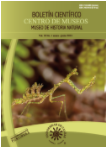Authors
Abstract
Objectives: Analyzing environmental risk five sampling stations on the Cauca, due to the presence of phenol, previously detected, especially on the basis of some of the alkyl phenols found at risk of endocrine disruption in mammals including man. Scope: Qualitative chemical inventory of water collected and analyzed. Methodology: The technique of gas chromatography coupled to mass spectrometry was applied to identify your risk may, with the support of databases: Pubmed Compounds, Chem Pubmed, Science Direct, IARC –International Agency of Research on Cancer– and Leaves of Security –MSDS–. Main results: 70 organic compounds, among which are some alkyl phenols, some of which pose a risk to human health and aquatic ecosystems, others are without risk characterization and a last group without information were identified. Conclusions: It is a pioneering work to understand the risks of urban, agricultural and industrial pollution of the river, passing through the city of Cali and will be useful for the control entities in the region, such as the Regional Autonomous Corporation of Valley Cauca, CVC, may take the measures necessary for the proper management of the river.
References
CHIHOUNG, C., PEARSON, A.M. & GRAY, J.I., 1992.- Effects of synthetic antioxidants (BHA, BHT and PG) on the mutagenicity of IQ-like compounds. Food Chemistry, 43: 177-183.
JIMÉNEZ-BOTERO, G.A. & SOTO-DUQUE, A., 2014.- Análisis del riesgo ambiental potencial por compuestos orgánicos presentes en aguas del río Cauca, a su paso por la zona urbana de la ciudad de Cali (Colombia): Tesis de Magister en Desarrollo Sostenible y Medio Ambiente, Universidad de Manizales, Facultad de Ciencias Contables, Económicas y Administrativas.
JIMÉNEZ-BOTERO, G.A., SOTO-DUQUE, A. & ÁLVAREZ-LEÓN, R., 2013.-Análisis del riesgo ambiental por alquil-fenoles presentes en aguas del río Cauca a su paso por la zona urbana de la ciudad de Cali (en) Memorias de Resúmenes del XLVIII Congreso Nacional de Ciencias Biológicas, Bogotá D.C., 6 a 9 de octubre, 2013 (resumen, p. 340). Rev. Asoc. Colomb. de Ciencias Biológicas, 25 (Supl. 01): 1-519.
KOUKI-INAI, T., KOBUKE, S., NAMBU, T., TAKEMOTO, E., KOU, H., NISHINA, M.F. et al., 1988.- Hepatocellular tumorigenicity of butylated hydroxytoluene administered orally to B6C3F1 mice. Cancer Science, 79: 49-58.
LARMAT, F.E., SOTO-DUQUE, A. & BRAVO, E., 2009.- Evaluación de la actividad mutagénica del río Cauca en el área urbana de la ciudad de Cali - Colombia, por medio del test de Ames. Informe a COLCIENCIAS / Universidad del Valle / Universidad Autónoma de Occidente. Cali (Valle).
NCBI PUBCHEM COMPOUND., 2005.- Phenol,2-methyl-4-(1,1,3,3-tetramethylbutyl)- Compound Summary (CID 75206). National Center for Biotechnology Information, U.S. National Library of Medicine 8600 Rockville Pike, Bethesda MD, 20894, USA.
SIGMA-ALDRICH., 2012.- Material Safety Data Sheet. Product name: 4-(1,1,3,3-Tetrametilbutil)-o-cresol. Version 5.0.
TOXNET HOME-HSDB., 2012.- 4-(1,1,3,3-Tetramethylbutyl) PHENOL CASRN: 140-66-9 National Center for Biotechnology Information, U.S. National Library of Medicine 8600 Rockville Pike, Bethesda MD, 20894 USA. Disponible en: http://toxnet.nlm.nih.gov/.

 PDF (Español)
PDF (Español)
 FLIP
FLIP






















